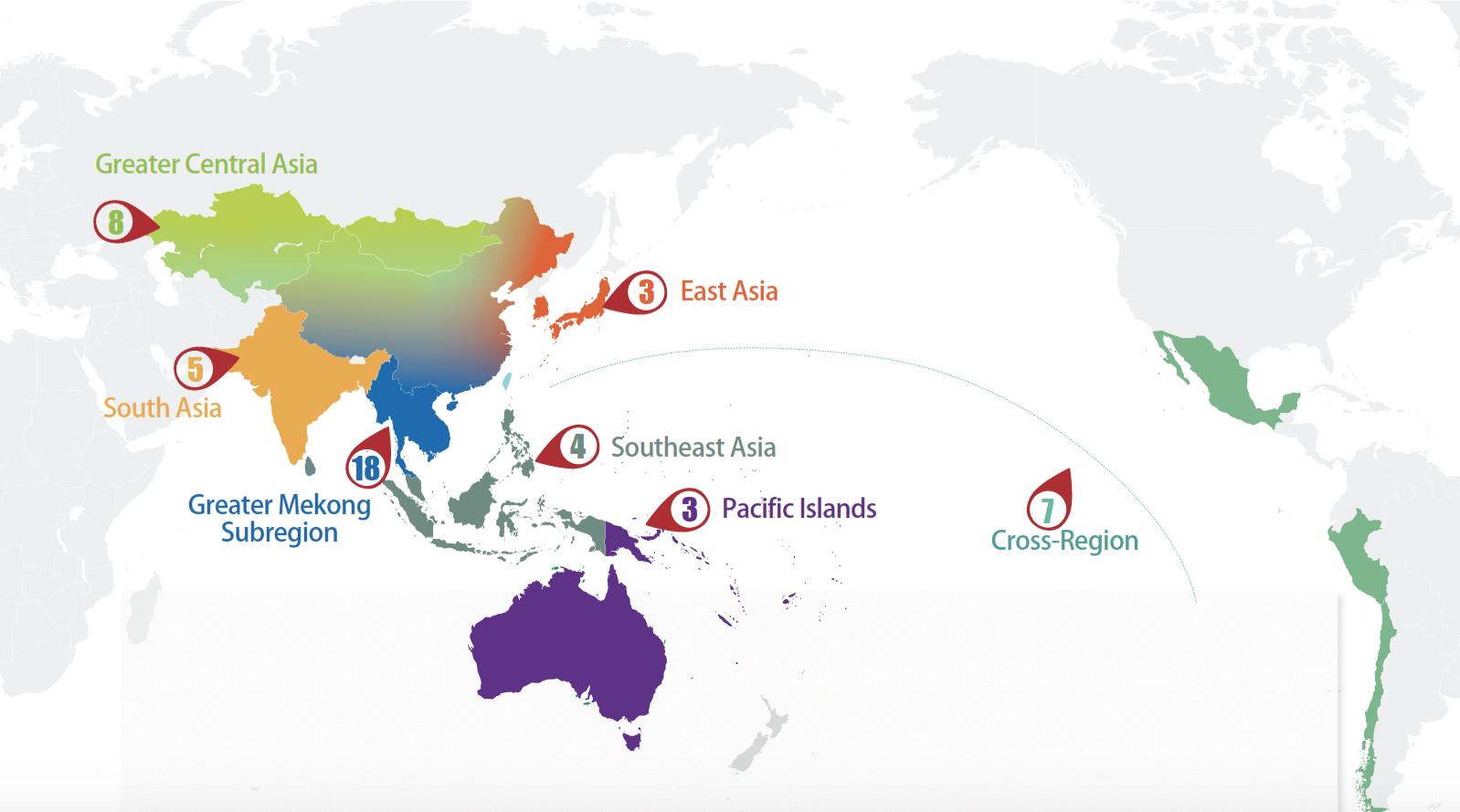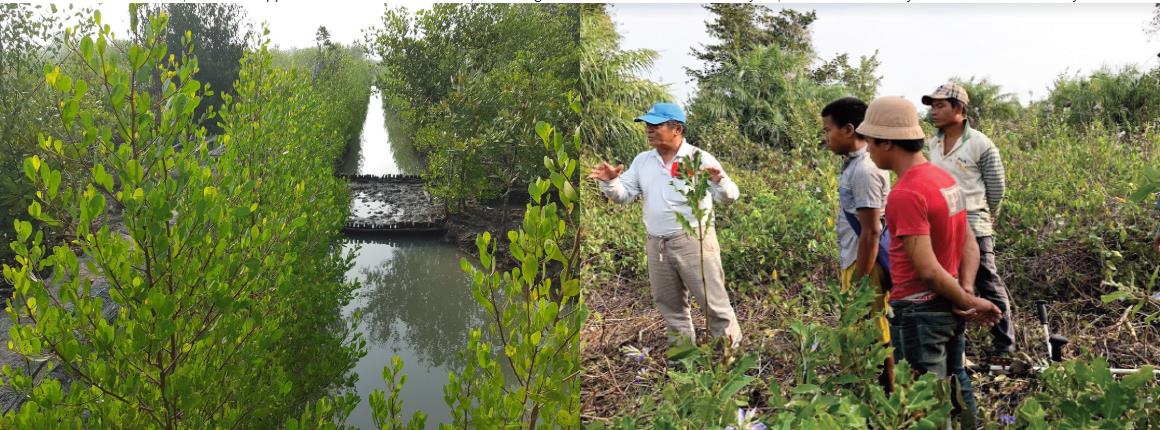Project facts
APFNet is dedicated to demonstrating and promoting best practices and successful models for sustainable forest management (SFM) and forest rehabilitation in the Asia-Pacific region. This is achieved by providing financial and technical support to projects that are tailored to the needs of individual economies and the overall region. In general, APFNet-funded projects aim to rehabilitate degraded forests and increase forest cover, promote SFM to enhance the ecological functions and health of forests, and enhance the contribution of forests to socioeconomic development and local livelihoods.
As of September 2020, APFNet has conducted 50 projects in 22 economies in the Asia-Pacific region and distributed approximately USD 39 million through the projects. APFNet’s projects aim to achieve a collaborative and balanced approach for responding to the needs of economies in the different subregions shown in Figure 1.
 Figure 1. APFNet project distribution in the Asia-Pacific region.
Figure 1. APFNet project distribution in the Asia-Pacific region.
All APFNet projects are classified into three categories: demonstration projects, policy and research projects and capacity-building projects. A common theme of APFNet projects is to explore and enhance the interface between policy, science and practice, to meet the forest management needs of economies. As of September 2020, APFNet has conducted 35 demonstration projects and established over 4,000 ha of demonstration sites that involve the testing of novel policies, concepts and techniques on the ground to pilot and improve forest management practices; 13 research projects that aim to contribute to scientific knowledge in areas relevant for member economies, such as carbon accounting or forest transition; and two capacity-building projects that help policymakers, local foresters, researchers and communities to improve their planning and implementation of forest rehabilitation and forest management efforts.
Project topics
All of these projects are working on a variety of forestry-related topics. The key themes of APFNet projects so far are described below.
Forest rehabilitation
APFNet works to align and add value to existing international, regional and national initiatives to advance forest restoration, such as the Bonn Challenge, the New York Declaration on Forests, the United Nations Strategic Plan 2017–2030 and the Sydney APEC Leaders' Declaration on Climate Change, Energy Security and Clean Development.
APFNet has supported over 20 projects with over 4,000 ha of demonstration sites. These sites target the restoration of degraded forests so that they can regain their health, provide ecosystem services and benefit local livelihoods. To date, APFNet forest restoration projects have become models for the application of new restoration techniques in their respective economies, including Cambodia, China, Indonesia, Mongolia, Nepal, Papua New Guinea, Viet Nam and so forth. Many approaches have been used including forest landscape restoration, assisted natural regeneration, agroforestry, planting of key species and soil restoration by using nitrogen-fixing tree species. Additionally, forest management approaches, such as thinning, can be used to “restore” forest ecosystems to more natural states by removing some trees from monocultures and introducing native species through enrichment planting.
Sustainable forest management and planning
Forests are valuable resources that provide timber, clean water, non-timber forest products and oxygen. However, to ensure their ability to provide such resources in the long term, they have to be managed sustainably. Management that only looks at the next few years will likely fail to consider the long-term impacts of human activities in the forest. Thus, APFNet has supported many economies, such as Cambodia, Fiji and Myanmar to develop medium- and long-term forest management plans (FMPs). These FMPs can be adjusted to local circumstances and needs, ranging from participatory micro-planning to community forest management plans, national-level FMPs, stand-level operational plans and even 100-year FMPs.
At the same time, SFM is only part of a variety of forest management approaches that have been demonstrated in different APFNet projects. For example, close-to-nature forest management (China), agroforestry (Chinese Taipei), multi-functional forestry (Cambodia) and integrated watershed management (Myanmar). Tools such as marking target trees, thinning, pruning, target diameter-based harvesting, inter-planting and fire management have also been used in these projects.
Forest and communities
Community forestry is a well-established approach for forest management in the Asia-Pacific region and it has become a powerful vehicle for improving local livelihoods. The reality is that forests and communities cannot be separated. Trying to manage forests without involving local communities is doomed to failure as any success depends on the support of the local people. And that support often hinges on the ability of a given project to enable communities to participate in decision-making activities, the management of forests and the development of livelihood alternatives, especially when the project is impacting traditional sources of income (Figure 2).
APFNet projects have tackled these problems in different ways. Many, for example in Cambodia, Malaysia and Nepal, have incorporated participatory planning and forest management. Others, like projects in China, Myanmar, Nepal and Papua New Guinea have focused on developing sustainable livelihood alternatives, such as small-scale forest enterprises, integrated aquaculture and new ideas in the agricultural domain, such as mushroom farming.

Figure 2. APFNet projects supporting community forestry.
Watershed planning and management
While watershed management commonly includes forest management, much more is involved. A watershed, key to providing clean water for local communities and often large cities, is a mosaic of landscapes, spanning and interconnecting agricultural land, forests, human settlements, pastures and many other types of land.
APFNet has supported integrated watershed management in a number of projects covering the following six watersheds: the Mekong River Watershed in the Greater Mekong Subregion (GMS), the Prek Thnot Watershed in Cambodia, the Miyun Reservoir Watershed in China, the Solo Upper Watershed in Indonesia, the Sungai Medihit Watershed in Malaysia, and the Irrawaddy River Watershed in Myanmar.
 Figure 3. Mud crab pond with mangrove restoration (left) and training for local people on mangrove restoration (right).
Figure 3. Mud crab pond with mangrove restoration (left) and training for local people on mangrove restoration (right).
Forest and climate
Forests and climate have an intricate relationship. Although forests are the primary “green” way to mitigate climate change by capturing carbon, they also need comprehensive climate change adaptation strategies as trees can easily live beyond 100 years. In several economies, APFNet has sponsored research projects to improve the accuracy of measuring the carbon bound in forests, such as carbon mapping in the GMS, an improvement of overall carbon content calculations in Thai forests and the correct accounting of CO2 emitted from peat forest burning in Indonesia. These projects will improve national reporting to the United Nations Intergovernmental Panel on Climate Change.
In order to facilitate adaptation, APFNet has partnered with the University of British Colombia to develop climate and ecological models to predict new species climate niches under different climate change scenarios in North America and particularly in the tropical forests of the Asia-Pacific region.
 Figure 4. The APFNet climate change adaptation project. Under the project, a new program called Climate AP, a user-friendly and scale-free tool that can generate monthly climate data for historical (1901–2019) and future years (2011–2100), was created. It is used by researchers from China, Chinese Taipei, Myanmar and Malaysia to predict niche changes for 15 important tree species and three forest ecosystems in the context of climate change and derive specific forest management recommendations from it.
Figure 4. The APFNet climate change adaptation project. Under the project, a new program called Climate AP, a user-friendly and scale-free tool that can generate monthly climate data for historical (1901–2019) and future years (2011–2100), was created. It is used by researchers from China, Chinese Taipei, Myanmar and Malaysia to predict niche changes for 15 important tree species and three forest ecosystems in the context of climate change and derive specific forest management recommendations from it.
Policy research
To bridge the gaps between science, policy and practice, APFNet encourages the development and restructuring of government policies, institutional arrangements and governance approaches that favour SFM and rehabilitation. APFNet’s research and policy development projects support theoretical and technical research in the forest sector, the assessment and improvement of existing forestry policies, and the development of forest strategies and strategic plans. Our projects have both provided member economies with technical assistance and increased the overall pool of knowledge through international forestry cooperation, especially on forestry’s contributions to poverty alleviation, forest transitions, policymaking and institutional development.
Capacity building
In addition to the topics mentioned, APFNet’s demonstration projects also integrate opportunities for capacity development, targeting policymakers, researchers and local communities. By the end of 2020, APFNet will have provided in-person and online training for over 20,000 participants on a wide range of topics such as community forest management, agroforestry, close-to-nature forestry, forest fire prevention and control, geographic information systems, mangrove management and ecotourism.









